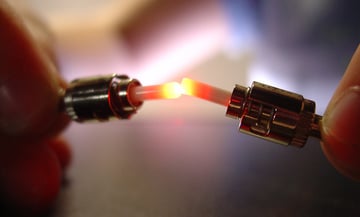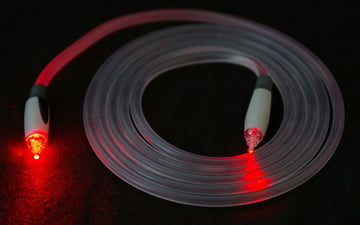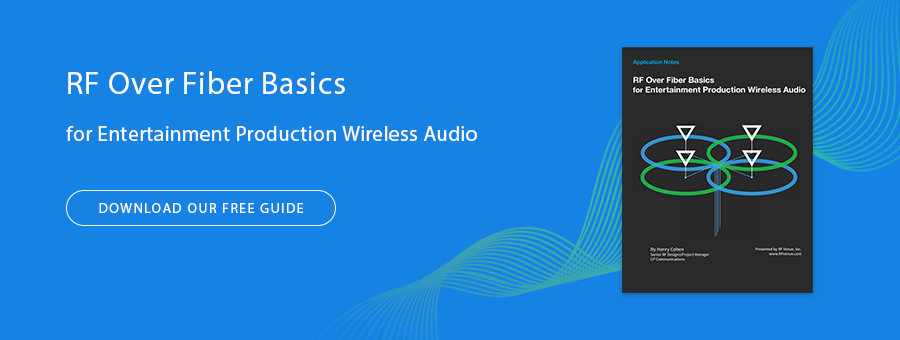Multi-Mode vs. Single-Mode Fiber-Optic Cable: Debates and Differences

If you must know one thing about fiber-optic cable, it’s the difference between single-mode and multi-mode strands.
Fiber-optic cable offers a bewildering variety of connectors, operational wavelengths, bundles/tacs, and more, but all of them boil down to being one of these two types: single-mode or multi-mode.
[UPDATE: follow-up: "Every Fiber-Optic Connector Used in Entertainment Production in One Giant Infographic"]
This article does not attempt to cover fiber-optic cable in depth. Rather, we're taking it piece by piece (more articles to follow), and this installment is essentially to hammer home the point that these two types exist, and they aren't interchangeable.
When working with fiber, you must know the differences between multi-mode and single-mode. Otherwise, you risk purchasing the wrong equipment or cable, or plugging incompatible cable into an optical device and compromising or destroying the signal.
Audio professionals working with fiber-optic (optical) devices for the first time are sometimes overwhelmed by unfamiliar vocabulary and the practical differences between optical fibers and other, more commonplace cable types within the world of production and installed sound, like audio, CAT5, and coaxial cable.
Fiber-optics are an essential backbone to every advanced communication infrastructure worldwide, though the world of computer networking, IT, mobile and wired telecommunication, where optical transport is most common, doesn’t always intersect with pro sound, and so a simple Google search for clarification can be as confusing as it is helpful.
These basic, conceptual differences between single-mode and multi-mode may help in choosing single-mode over multi-mode if you’re thinking about purchasing an optical device for audio, video, or RFoF.
What is fiber-optic cable?
Fiber-optic cable is the transmission medium for signal in optical communications systems.
The simple explanation of how optical transmission works is that information can be modulated into high frequency pulses of light, emitted by either an LED or a laser, and pointed into an optical fiber. Those light pulses travel through the fiber and are demodulated back into information by an optical receiver at the destination.
A fiber-optic strand is sometimes called, for purposes of explanation, a “light tube,” because light is able to travel easily through a transparent medium, like glass or clear plastics, surrounded by outer sheaths of materials with special characteristics that “trap” or contain the light within the inner strand(core)—a physical phenomenon that allows optical signal to travel very long distances and carry a large amount of information with relatively little transmission power.

The full, detailed explanation veers into hard physics, including quantum physics, which we steer clear of here on Audio Gloss, although the stuff is so important that the invention and study of optical fiber has been awarded Nobel Prizes. Optical communication has its own scientific discipline: photonics, but luckily we don’t need a doctorate in photonics (or a Nobel Prize) to use fiber correctly.
Technical differences between single-mode and multi-mode cable
There are lots of them. But here are the most important:
- The diameter of their cores.
- The light source and modulation used by optical transmitters.

Core Diameter
Single-mode core diameters are much smaller than multi-mode. The standard used in broadcasting and production is 9.5 microns, although there are other diameters available, they are seldom encountered in fiber-optic devices designed for use in A/V environments.
A micron is one thousandth of one millimeter. 9.5 microns is therefore extremely small. Possibly too small to see with the naked eye.

Above is a photomacrograph by Dennis van Zuijlekom of a fiber cable with the buffer and cladding stripped away to reveal the core. I don’t know what scale this is, but the ratio between buffer and core diameters makes me think this is multi-mode fiber.
Multi-mode core diameters, in A/V, are either 50 microns, or 62.5, with 50 microns more prevalent. Again, other diameters are manufactured for other applications, but we don’t often see them in A/V.

Above is an electron microscopy image of a 6 micron carbon filament lain over a 50 micron human hair. That’s how small we’re talking.
Light Source
Multi-mode devices usually use an LED as a light source. If you want to know exactly why LEDs are used in multi-mode devices, be my guest.
Single-mode devices use a laser, or laser diode, to produce light injected into the cable. Lasers produce light that is coherent, and a beam that can be very thin.
As far as we know, there are no devices for audio or video professionals that accept both single and multi-mode fiber.
You can't connect multi-mode fiber to single-mode devices, or vice versa.
Incompatibility between types has as much to do with the fiber type as it does with the device and the light source that generates the signal.
Practical Differences between Single-Mode and Multi-Mode Cable
Single-Mode
- Single-mode systems are usually, but not always more expensive because of the laser diodes and precise calibration required to inject light into the cable. The costs of single vs multi-mode cable itself are negligible, but single-mode devices often cost more.
- Light travels a longer distance inside single-mode cable than it does inside multi-mode. How much farther depends on many factors, but the rule of thumb we’ve heard from engineers is single-mode signal can survive up to 30 kilometers.
- The bandwidth (amount of information in the signal) of single-mode is higher than multi-mode. Um, much higher: as much as 100,000 GHz!
- Since the entrance pupil of single-mode is so small (~9 microns), single-mode connectors must be kept very, very clean. Even a microscopic particle blocking the pupil can partially or completely block signal.
Multi-Mode
- Multi-mode systems usually cost less. Although, again, the fiber cable itself is about the same price as single-mode, the LED components used as transmitter optics in multi-mode devices are less expensive to purchase and calibrate, and so multi-mode systems as a whole are less expensive.
- Cable runs are much shorter than with single-mode, but still much greater than coaxial cable. 2 kilometers seems to be the maximum recommended distance floated by engineers.
- Multi-mode bandwidth is smaller than single-mode—up to 1 GHz vs 100,000 GHz—but still enough transmit a large amount of A/V signal, data, or controls.
Live production rental/sales houses, and broadcast houses usually standardize on devices that use either single-mode or multi-mode cable. Some companies have only single-mode in inventory, while others have only multi-mode. There are practical reasons why some companies standardize on one or the other. Broadcast companies, for example, will often use single-mode, because their trucks may be many miles from an on-site location, or they may require long distance transit of signal from remote set to studio, or studio to studio, where microwave or satellite links are cost-prohibitive or impossible. Whereas a general services A/V production company or rental house that works indoor venues may not see a need for long distance propagation using single-mode, and so standardize around multi-mode.
From what we know, duplex (two-way) communication through a single strand can only be done through single-mode cable, using something called wave division multiplexing.
However, since the optical cores of both single-mode and multi-mode are so small, you can pack a lot of strands into one cable. It’s very common to have 2 (especially two, called a "pair" for duplex), 4, or dozens of strands per cable, to allow a different method of duplex communication and/or splicing out to multiple devices at the destination site, as well as, with multi-mode, larger bandwidths than would be possible with a single strand.
*Leading image courtesy Srleffler
*Multi vs single diagram courtesy Mrzeon
*F/O cross-section courtesy Bob Mellish
*Macrograph courtesy
*SEM image courtesy Saperaud~commonswiki
Alex Milne
Alex Milne was Product Marketing Manager and Digital Marketing Manager for RF Venue, and a writer for the RF Venue Blog, from 2014-2017. He is founder and CEO of Terraband, Inc., a networking and ICT infrastructure company based in Brooklyn, NY., and blogs on spectrum management, and other topics where technology,...
More from the blog

Longer Runs, Less Cost With RF Over Fiber Optic Conversion Systems

Diminishing Returns: At a Certain Point, Using Coax Is Insane

Fiber Optic Hygiene for RF over Fiber Conversion Systems
Subscribe to email updates
Stay up-to-date on what's happening at this blog and get additional content about the benefits of subscribing.

